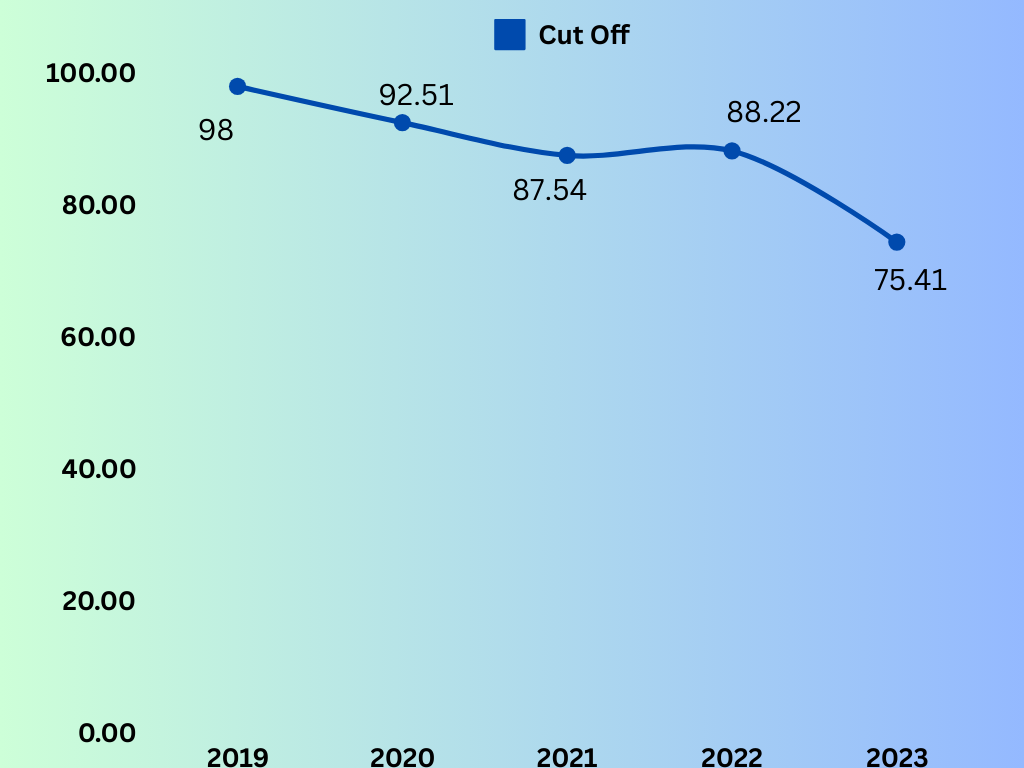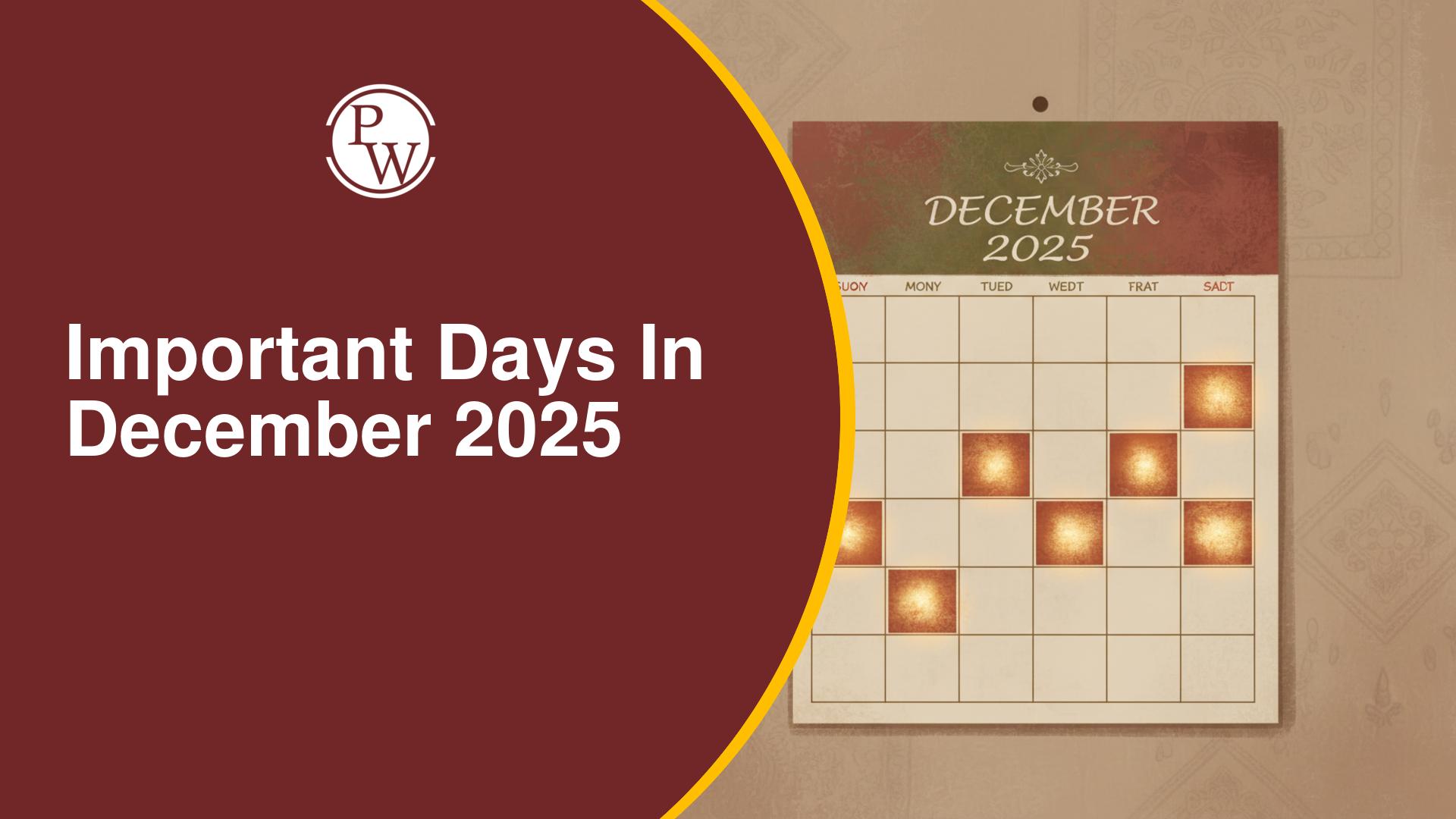

The UPSC Cut Off signifies the lowest scores needed by candidates to advance to the next rounds of the Civil Services Examination, which comprises the Preliminary Examination, the Mains Examination, and the Personality Test (Interview). Every stage has its own cutoff threshold, and only those candidates who meet these standards are eligible to progress to the subsequent phase.
In this article, we will have a look at the cut off trend analysis of the year 2023 as well as the Cut off trend analysis of the last 5 years .UPSC Cut off Trend Analysis - Overview
The UPSC Cut off 2023 is announced on the official website shedding light on some interesting trends. For the first time in the last 5 years, the UPSC Prelims cut off is lowest and stands at 75.41 for the General category. The past 5 years' UPSC Cut off trends are displayed below:
UPSC Cut off Trend Analysis 2023
In order to be eligible for the UPSC CSE Mains 2023, candidates need to achieve a minimum score of 33% in the GS II (CSAT) paper of the prelims examination. The UPSC cut off scores for different categories, considering the difficulty level of the UPSC CSE Prelims 2023 exam has fallen to 75.41 for general category candidates. Below are the UPSC cut off scores for each category as announced on 18 April 2024 are as follows::| UPSC Cut off 2023 | |||
| Category | Prelims Cut Off | Mains Cut Off | Final Cut off |
| General | 75.41 | 741 | 953 |
| EWS | 68.02 | 706 | 923 |
| OBC | 74.75 | 712 | 919 |
| SC | 59.25 | 694 | 890 |
| ST | 47.82 | 692 | 891 |
| PwBD 1 | 40.40 | 673 | 894 |
| PwBD 2 | 47.13 | 718 | 930 |
| PwBD 3 | 40.40 | 396 | 756 |
| PwBD 5 | 33.68 | 445 | 589 |
UPSC Cut off Trend Analysis 2022
The UPSC CSE Cut Off for 2022 was disclosed simultaneously with the final outcome on May 23, 2023. In the General Category, the UPSC CSE Prelims Cut Off for 2022 stood at 88.22. The table below contains the list of category wise cut off of UPSC Prelims 2022:| UPSC Cut off Trend Analysis 2022 (Prelims) | |
| Category | UPSC Cut Off |
| General | 88.22 |
| EWS | 82.83 |
| OBC | 87.54 |
| SC | 74.08 |
| ST | 69.35 |
| PwBD-1 | 49.84 |
| PwBD-2 | 58.59 |
| PwBD-3 | 40.04 |
| PwBD-4 | 41.76 |
| UPSC Cut off Trend Analysis 2022 (Mains) | |
| Category | UPSC Cut Off |
| General | 748 |
| EWS | 715 |
| OBC | 714 |
| SC | 699 |
| ST | 706 |
| PwBD-1 | 677 |
| PwBD-2 | 706 |
| PwBD-3 | 351 |
| PwBD-4 | 419 |
UPSC Cut off Trend Analysis Last 5 Years Prelims
The cutoff marks for the UPSC Prelims play a crucial role in shaping the path of aspirants aiming to become civil servants in India. The Preliminary Examination consists of two papers: General Studies I and General Studies II. It's crucial to understand that while General Studies I determines merit ranking, General Studies II is only required to be passed with a minimum of 33%. The table below contains the list of the last 5 years cut off trends analysis of the UPSC Prelims exam, which is distributed category wise:| UPSC Cut off Trend Analysis Last 5 years Prelims | |||||
| Category | 2022 | 2021 | 2020 | 2019 | 2018 |
| General | 88.22 | 87.54 | 92.51 | 98 | 98 |
| OBC | 87.54 | 89.12 | 89.12 | 95.34 | 96.66 |
| ST | 69.35 | 70.71 | 68.71 | 77.34 | 83.34 |
| SC | 74.08 | 75.41 | 74.84 | 82 | 84 |
| PWD 1 | 49.84 | 68.02 | 70.06 | 53.34 | 73.34 |
| PWD 2 | 58.59 | 67.33 | 63.94 | 44.66 | 53.34 |
| PWD 3 | 40.40 | 43.09 | 40.82 | 61.34 | 40.00 |
| PWD 4 | 41.76 | 45.80 | 42.86 | 61.34 | 45.34 |
| EWS | 82.83 | 80.14 | 77.55 | 90 | ------ |
UPSC Cut off Trend Analysis Last 5 Years Mains
The UPSC Mains comprises nine papers, with merit ranking based on seven of them. The English Language Paper and the Indian Language Paper, however, are qualifying papers. Candidates need to attain a minimum qualifying score in these language papers as specified by the UPSC. The table below contains the list of the last 5 years cut off trends analysis of the UPSC Mains Exam, which is distributed category-wise:| UPSC Cut off Trend Analysis Last 5 Years Mains | |||||
| Category | 2022 | 2021 | 2020 | 2019 | 2018 |
| GENERAL | 748 | 745 | 736 | 751 | 774 |
| OBC | 714 | 707 | 698 | 718 | 732 |
| ST | 706 | 700 | 682 | 699 | 719 |
| SC | 699 | 700 | 680 | 706 | 719 |
| PWD 1 | 677 | 688 | 648 | 663 | 711 |
| PWD 2 | 706 | 712 | 699 | 698 | 696 |
| PWD 3 | 351 | 388 | 425 | 374 | 520 |
| PWD 4 | 419 | 560 | 300 | 561 | 460 |
| EWS | 715 | 713 | 687 | 696 | ---- |
UPSC Final Cut off Trend Analysis Last 5 Years
The final cut off marks for the UPSC is established by combining candidates' scores from both the Mains Examination as well as the Personal Interview. The main examination consists of seven papers, whereas the Interview stage accounts for the rest. Candidates' performances are assessed, and the ultimate cut off is determined by aggregating their scores from both stages. The table below contains the list of last 5 years Final cut off trend Analysis of the UPSC exam, which is distributed category-wise:| UPSC Final Cut off Trend Analysis Last 5 Years | |||||
| Category | 2022 | 2021 | 2020 | 2019 | 2018 |
| General | 960 | 953 | 944 | 961 | 982 |
| OBC | 923 | 910 | 907 | 925 | 938 |
| SC | 893 | 886 | 875 | 898 | 912 |
| ST | 900 | 883 | 876 | 893 | 912 |
| PWD 1 | 879 | 892 | 867 | 861 | 899 |
| PWD 2 | 913 | 932 | 910 | 890 | 908 |
| PWD 3 | 632 | 689 | 675 | 653 | 754 |
| PWD 4 | 590 | 701 | 465 | 708 | 718 |
| EWS | 926 | 916 | 894 | 909 | ----- |
Key Factors Influencing UPSC Cut Off Trends
The UPSC cut off marks for various exams, such as the CSE, are determined by a variety of factors. These factors can vary from year to year and can influence the difficulty level and overall performance of candidates. Here are some key factors that influence UPSC cut off marks:- Difficulty Level of the Exam: The complexity and difficulty level of the examination plays a significant role in determining the cut off marks. If the examination is tougher, the cut off marks are likely to be lower, and vice versa.
- Number of Vacancies: The total number of vacancies available for a particular examination can influence the cut off marks. Generally, if the number of vacancies is higher, the cut off marks may be lower, and if the vacancies are limited, the cut off may be higher.
- Performance of Candidates: The overall performance of candidates in the examination also affects the cut off marks. If candidates perform exceptionally well, the cut off marks may increase, and if the performance is comparatively lower, the cut off marks may decrease.
- Reservation Policy: UPSC follows a reservation policy for various categories such as SC (Scheduled Castes), ST (Scheduled Tribes), OBC (Other Backward Classes), and EWS (Economically Weaker Sections). The cut off marks for these categories may vary based on the reservation policy.
- Previous Year's Cut Off: The cut off marks from previous years can serve as a reference point for determining the current year's cut off marks. UPSC may consider trends from previous years while setting the cut off marks.
- Normalisation Process: In exams where multiple sessions are conducted, UPSC may adopt a normalisation process to ensure fairness across different sessions. This process can also impact the final cut off marks.
UPSC Cut off Trend Analysis FAQs
What is the minimum cut off in UPSC?
The minimum cutoff for the UPSC Civil Services Exam varies each year based on factors like the difficulty level of the paper and the number of vacancies. Generally, it hovers around 40-50% for the general category and is lower for reserved categories.
What are the passing marks for the UPSC exam?
The UPSC exam consists of different stages, each with its own passing criteria. Generally, candidates need to score at least 33% in the Preliminary Exam to qualify for the Main Exam. In the Main Exam, marks are allocated per subject, and candidates must achieve the cut-off determined by UPSC.
What is the minimum rank in UPSC?
The minimum rank to be eligible for the Indian Administrative Service (IAS) is 79 for the General category, 354 for EWS, 323 for OBC, 510 for SC, 505 for ST, and 761 for the PwD category.
Is 60% required for UPSC?
No specific minimum percentage is necessary to obtain your graduation, as you only need to have completed a Bachelor's degree from a university recognized by the government. This encompasses any technical or professional degree that holds government recognition.
How many IAS are selected every year?
Annually, approximately 180 individuals are chosen for the Indian Administrative Services (IAS) via the UPSC Civil Services Examination.
🔥 Trending Blogs
Talk to a counsellorHave doubts? Our support team will be happy to assist you!

Free Learning Resources
PW Books
Notes (Class 10-12)
PW Study Materials
Notes (Class 6-9)
Ncert Solutions
Govt Exams
Class 6th to 12th Online Courses
Govt Job Exams Courses
UPSC Coaching
Defence Exam Coaching
Gate Exam Coaching
Other Exams
Know about Physics Wallah
Physics Wallah is an Indian edtech platform that provides accessible & comprehensive learning experiences to students from Class 6th to postgraduate level. We also provide extensive NCERT solutions, sample paper, NEET, JEE Mains, BITSAT previous year papers & more such resources to students. Physics Wallah also caters to over 3.5 million registered students and over 78 lakh+ Youtube subscribers with 4.8 rating on its app.
We Stand Out because
We provide students with intensive courses with India’s qualified & experienced faculties & mentors. PW strives to make the learning experience comprehensive and accessible for students of all sections of society. We believe in empowering every single student who couldn't dream of a good career in engineering and medical field earlier.
Our Key Focus Areas
Physics Wallah's main focus is to make the learning experience as economical as possible for all students. With our affordable courses like Lakshya, Udaan and Arjuna and many others, we have been able to provide a platform for lakhs of aspirants. From providing Chemistry, Maths, Physics formula to giving e-books of eminent authors like RD Sharma, RS Aggarwal and Lakhmir Singh, PW focuses on every single student's need for preparation.
What Makes Us Different
Physics Wallah strives to develop a comprehensive pedagogical structure for students, where they get a state-of-the-art learning experience with study material and resources. Apart from catering students preparing for JEE Mains and NEET, PW also provides study material for each state board like Uttar Pradesh, Bihar, and others
Copyright © 2025 Physicswallah Limited All rights reserved.
Get App











